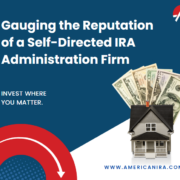Which Self-Directed IRA Type is Best For Your Retirement Strategy?
No two Self-Directed IRAs are made alike.
We’re not talking about investments, either—we’re talking about the IRAs themselves. Even if you’re just starting out with your retirement investing, you’ve probably heard of a few of them, such as 401(k) and Roth IRAs. But what about the IRAs themselves makes them different—not just the name? The more you investigate, the more you’ll learn whether or not your money is truly where you want it to be.
So let’s explore a few of the Self-Directed IRA account types to find out which one is best for you, your lifestyle, and your plans for retirement:
IRA, or “Traditional” IRA
The traditional retirement account is pretty simple to understand. It’s a tax-deferred savings program, essentially, that allows you put aside money for retirement savings. With the traditional IRA, the key phrase is “tax-deferred,” because when you withdraw the money later, you will have to pay taxes on it. But that doesn’t mean it’s necessarily a bad thing—after all, you pay taxes on income as well.
The traditional IRA is actually the most common account that individuals use for their retirement. It’s not difficult to set up an IRA, either—it’s actually fairly easy to open one up in a matter of days so long as you have a source of funding. And since it’s tax-deferred, it can be easier on the wallet for many people who want to start with retirement saving but don’t have the money for something more.
Roth IRA
The Roth IRA is much like the Traditional IRA, except the contributions will not be tax-deductible. If that sounds like a disadvantage, consider also that once you turn 59 and a half and your account has been established at least five years, you can then withdraw funds from your Roth IRA—tax-free! The Roth IRA is therefore a kind of “tax-upfront” model. For many people who want to have as much money as possible when they retire, this is the ideal situation. It means you’re paying taxes now so you don’t have to pay them later. If you’re a prudent investor who likes to defer rewards, the Roth IRA might be for you.
Traditional 401(k)
The 401(k) is one of the most common IRAs out there, and it’s typically something you’ll get through your employer. You can make payroll deductions into your 401(k), usually automatically, which means it’s a major advantage for people who have a steady paycheck. Some employers also offer 401(k) matching in which they add in an amount to your 401(k) every time you add that same amount. An ideal situation is one in which you have an automatic payment going into the 401(k) every month so that you don’t even notice that you’re doing any saving!
SEP IRA
A Simplified Employee Pension plan allows employers to make contribute to employees’ retirement…what separates the SEP plan is that it allows an employer to also make contributions to their own retirement as well.
SIMPLE
Also known as a Savings Incentive Match Plan for Employees, this is a tax-favored retirement account that allows small employers (including self-employed) to set up to benefit their employees.
Do any of the above accounts sound like the kind of arrangement in which you’d be interested? Then you now have a roadmap in place for getting the right IRA that suits your situation. Give us a call at 866-7500-472(IRA) to learn about these types of plans and how they can fit within the strategy of a Self-Directed IRA that expands your portfolio and diversifies your investments.





